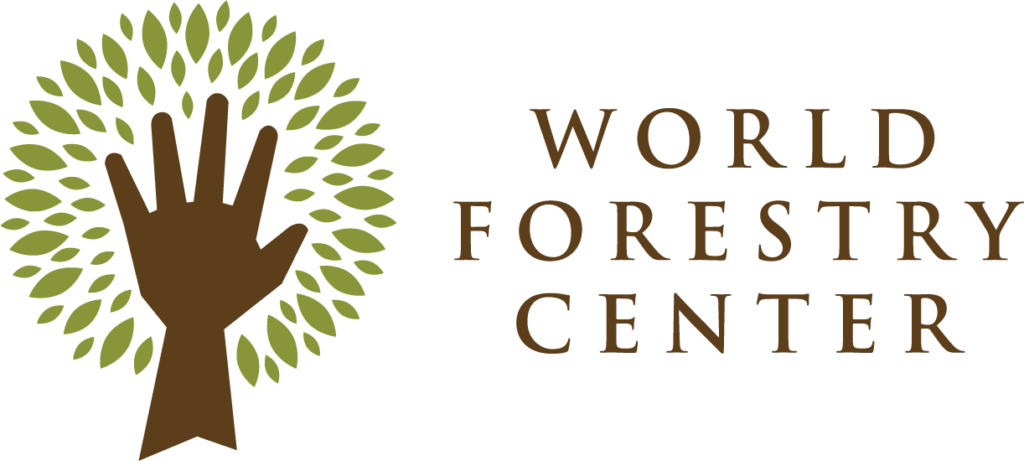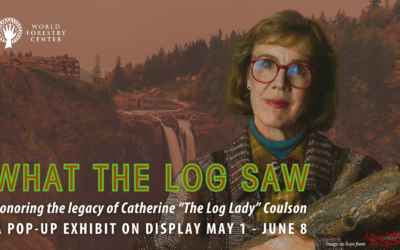Sasquatch: Ancestral Guardians

Featured Exhibition
May 30, 2025 – January 4, 2026 | Wed-Sun 10am-4pm
Included with Museum Admission
“We must walk lightly when we are between worlds with this sacred being.” – Phillip Cash Cash
Indigenous peoples have long been in relationship with and shared stories about sacred forest protectors, often called Sasquatch and Bigfoot. The works in this exhibition are made by Indigenous artists and honor generations of spiritual practices, storytelling, and tradition. Leave your preconceived notions behind and immerse yourself, not in the question of if Sasquatch exists, but rather, how are we existing with and honoring this non-human other.
This exhibition was created in collaboration with these Indigenous artists and the High Desert Museum in Bend, Oregon, which commissioned many of the artworks for the exhibition Sensing Sasquatch in 2024. Since then, artworks have been re–curated to align with the mission of World Forestry Center with new stories from the forests of the Pacific Northwest, new artwork and two additional artists.
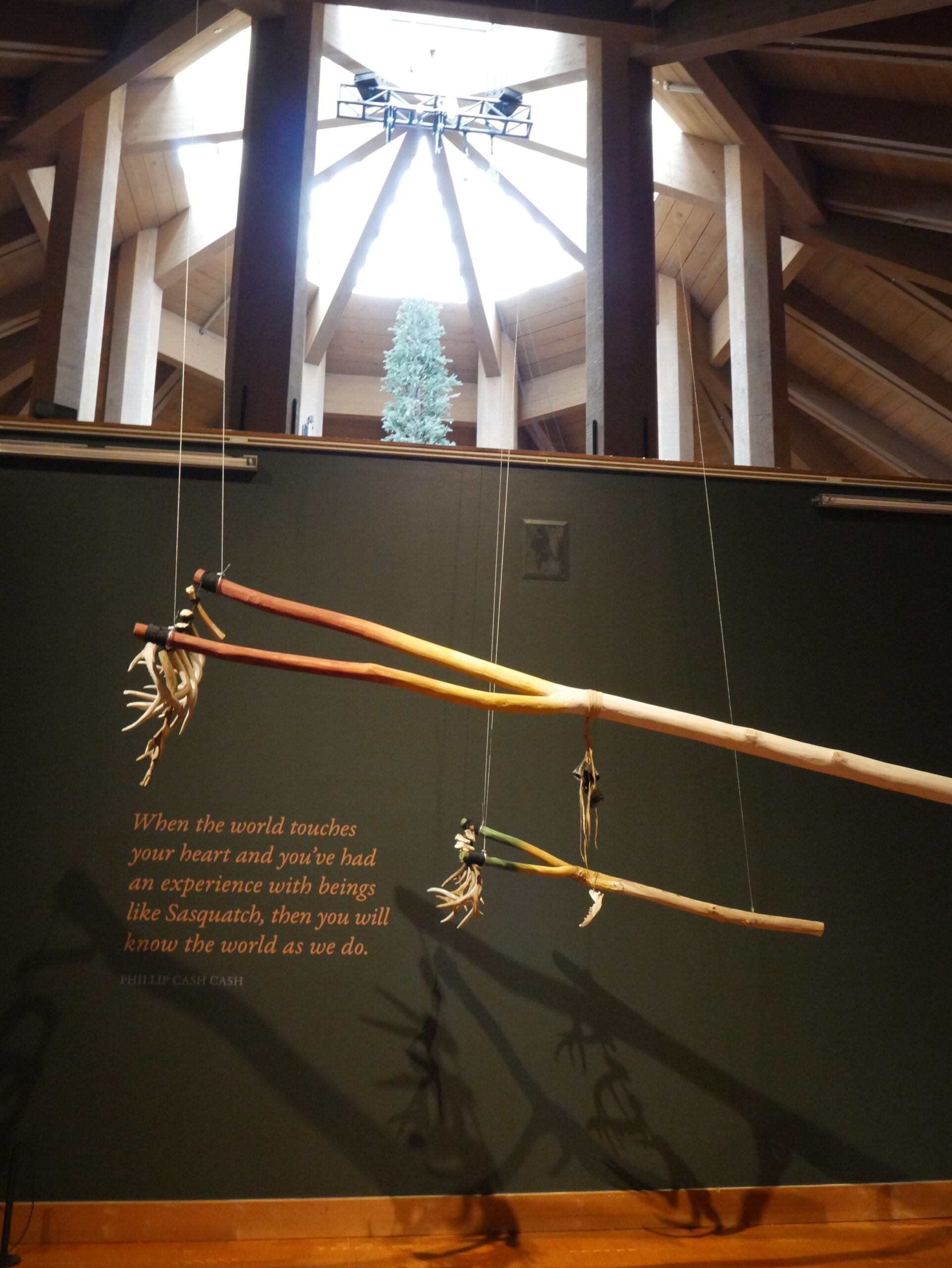
The exhibition is advised by and consists of original artwork by: Phillip Cash Cash, Ph.D. (Nez Perce, Cayuse), HollyAnna CougarTracks DeCoteau Littlebull (Yakama, Nez Perce, Cayuse, Cree), Charlene “Tillie” Moody (Warm Springs), Frank Buffalo Hyde (Nez Perce, Onondaga), Rocky LaRock (Salish), Greg Archuleta (Grand Ronde) and Joe Scott (Siletz).
“Not everything has to be explained to be known.”
– Frank Buffalo Hyde
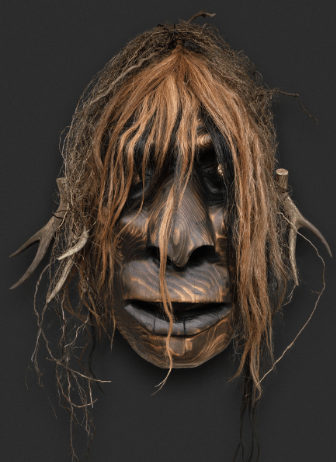
From t-shirts to beer cans and billboard advertisements, popular images of Sasquatch have become embedded in American culture, transforming the figure into a widely recognized pop icon. As a nod to this phenomenon, the entrance to the exhibition features a lighthearted homage to Sasquatch’s place in mainstream media. However, visitors are invited to set aside these familiar depictions in order to explore a deeper, more culturally grounded understanding. To encourage reflection on the kitsch and commercialization of Sasquatch, visitors are invited to “bring-your-own” Sasquatch sticker to place on the back of a car driving off into the distance—symbolically sending their preconceived notions away and preparing to enter a space of new perspectives and insight.
Unlike the mainstream portrayal of Sasquatch, this exhibition presents Sasquatch as a guardian figure within many Indigenous cultures.
Centered on Indigenous art and storytelling, the exhibition highlights the deep respect and reverence many Native peoples hold for this being. American pop culture situates Sasquatch within the wet rainforests of the Pacific Northwest. Though these non-human others exist here, they also traverse dry canyon lands, shrublands, valleys, open fields, and close to homes. For people who have encountered Sasquatch in these environments, they describe a life-altering experience that overwhelms them.
Whether or not Sasquatch exists is beside the point; in many Indigenous traditions, Sasquatch is regarded as an elder, a relative, and a spiritual guide who may appear to share important messages to humans. Such encounters are not merely sightings—they can be profound, transformative experiences.
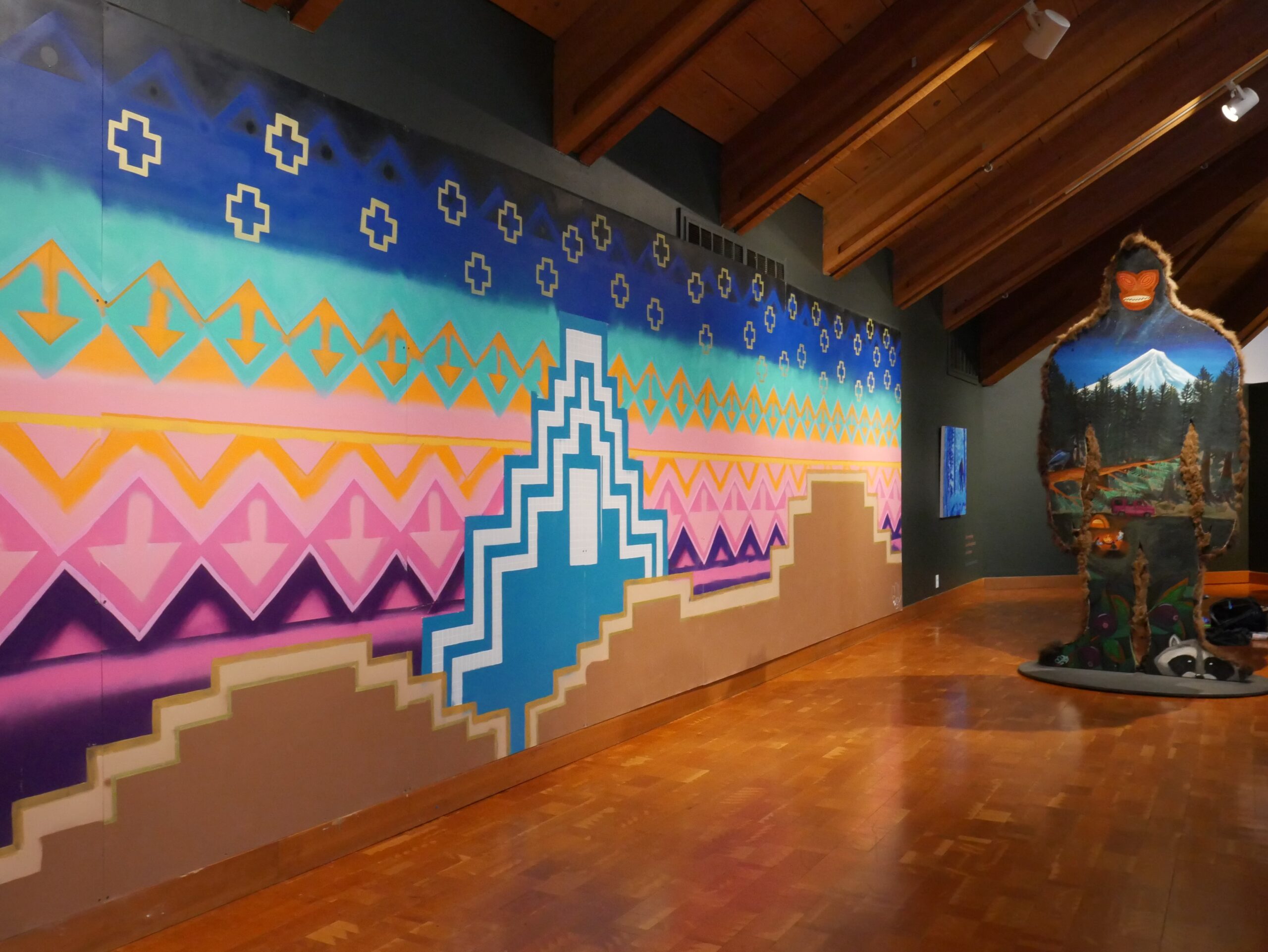
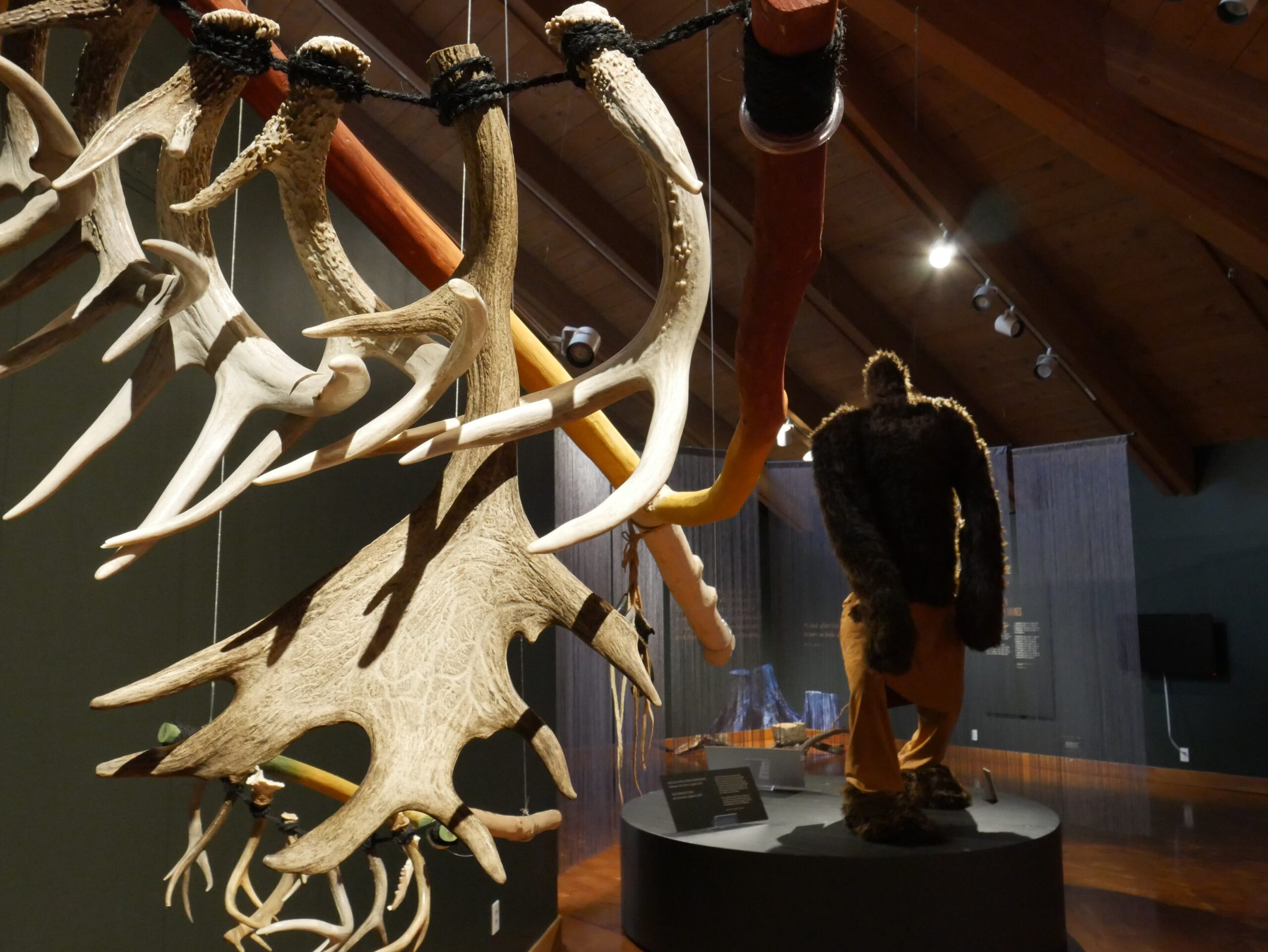
Many Indigenous people say that a Sasquatch encounter is a blessing. In turn, they have sought to protect Sasquatch’s anonymity and prevent human access to its wilderness habitat. HollyAnna CougarTracks DeCoteau Littlebull’s (Yakama, Nez Perce, Cayuse, Cree) whose artwork was originally commissioned for High Desert Museum, depicts Sasquatch as a protective “big sister” — not a predator but one who deserves respect and safeguarding. CougarTracks is an avid huckleberry gatherer, land protection advocate, and grew up on the Yakama Indian Reservation and considers herself “a protector of KwiKwiyai, or Bigfoot.”
This exhibition also challenges the common portrayal of Sasquatch as a shy, elusive creature that runs away to avoid human contact. It instead presents Sasquatch as a sacred being that communicates with people. Central to this perspective is the exhibitions lead advisor and co-creator, Phillip Cash Cash (Nez Perce, Cayuse), whose artwork was also originally commissioned for High Desert Museum’s Sensing Sasquatch—a set of rattles made from cottonwood—imagines tools that Sasquatch might use. Cash Cash is an artist, writer, and scholar of linguistic anthropology, as well as a passionate advocate for endangered languages. A fluent speaker of Nez Perce, he collaborates with Indigenous communities, museums, and professional organizations on initiatives that support cultural identity, advocacy, communication and healing.
“Sasquatch is something we don’t search out, but we recognize and respect.
We acknowledge that they are in the woods and must go into their home with respect.” – Charlene “Tillie” Moody
Charlene “Tillie” Moody (Warm Springs) created a 9-foot tall Sasquatch with a buffalo hide, with paintings inspired by the location of her tribe that is situated on the edge of the mountains and desert. She hopes the artwork in this exhibition will spark visitor’s interest in the Native people of the areas where they live. “You know about Sasquatch, so let’s learn about the tribes here.”
Other art in this exhibition shows visitors that Sasquatch is a being that exists in the past, present, and future. Sasquatch has appeared in Indigenous artworks and stories for thousands of years and this continues today. A mask carved in 2023 by artist Rocky LaRock (Salish) shows visitors that knowledge of Sasquatch is both ancient and contemporary.
Frank Buffalo Hyde (Nez Perce, Onondaga) created an artwork specifically for this exhibition, sharing that, “Sasquatch is not just a being, but medicine. There is an interdimensionality to it, we are meant to believe in string theory and the possibility of parallel universes, and things that cannot be quantified. This would explain why it can’t be hunted or captured. The question is not about if it exists, rather how are we are existing with and honoring the medicine.”
Greg Archuleta (Grand Ronde) is Clackamas Chinook, Santiam Kalapuya, and Shasta, and a member of the Confederated Tribes of Grand Ronde. He is a story teller, teaches the culture and history of Western Oregon Tribes, including carving, basketry, Native art design, ethnobotany, and cedar hat making.
Joe Scott (Siletz) is a member of the Confederated Tribes of Siletz Indians and a descendant of the Rogue River Tribes of Southern Oregon. He lives and works on Kalapuya Illahee as Curriculum Director for the Traditional Ecological Inquiry Program and is a Traditional Fire Practitioner, cultural ecologist and traditional artist with an interest in using materials that hold weighted stories on their own.
Exhibit Champion
Rose E. Tucker Charitable Trust
The Stimson-Miller Foundation
Exhibit Partner
The Jackson Foundation
Exhibit Supporter
Frank Lumber Company
Umpqua Bank
Lone Rock Resources
Artists Supported By
National Science Foundation
INTERESTED IN BECOMING A SPONSOR?
CONTACT SARAH MARKS TODAY!
World Forestry Center seeks to bring people and forests together through innovative programs, unconventional collaborations, and meaningful experiences that create more entry points to the conversation about our forests. This includes our efforts to amplify the diversity of voices from community members who care deeply about the health of our forests and are taking powerful action to support them. When we learned about the creative collaboration between the High Desert Museum and a group of artists for the 2024 exhibition Sensing Sasquatch, we were inspired by how closely it aligned with our work.
Sasquatch: Ancestral Guardians is a newly curated exhibition that builds on that original work, expanding to include additional artists and reimagined to reflect our mission: to serve as a public gathering space where we explore new ways of sustainably caring for forests. We hope this exhibition encourages more people to engage in open, forest-based conversations—because the health of our forests impacts all of us.
